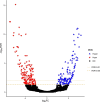Molecular responses of chicken embryos to maternal heat stress through DNA methylation and gene expression: a pilot study
- PMID: 40510536
- PMCID: PMC12159801
- DOI: 10.1093/eep/dvaf009
Molecular responses of chicken embryos to maternal heat stress through DNA methylation and gene expression: a pilot study
Abstract
Climate change, with its repercussions on agriculture, is one of the most important adaptation challenges for livestock production. Poultry production is a major source of proteins for human consumption all over the world. With a growing human population, improving poultry's adaptation to environmental constraints becomes critical. Extensive evidence highlights the influence of environmental variations on epigenetic modifications. The aim of this paper is therefore to explore chickens' molecular response to maternal heat stress. We employed Reduced Representation Bisulfite Sequencing to generate genome-wide single-base resolution DNA methylation profiling and RNA sequencing to profile the transcriptome of the brains of embryos hatched from dams reared under either heat stress (32°C) or thermoneutrality (22°C). We detected 289 significant differentially methylated CpG sites (DMCs) and one differentially methylated region (DMR) between heat stressed and control groups. These DMCs were associated with 357 genes involved in processes such as cellular response to stimulus, developmental processes, and immune function. In addition, we identified 11 genes differentially expressed between the two groups of embryos, and identified ATP9A as a target gene of maternal heat stress on offspring. This study provides a body of fundamental knowledge on adaptive mechanisms concerning heat tolerance in chickens.
Keywords: DNA methylation; chicken; embryos; epigenetics; heat stress.
© The Author(s) 2025. Published by Oxford University Press.
Conflict of interest statement
The authors declare no competing interests.
Figures








Similar articles
-
Genome-wide DNA methylome variation in two genetically distinct chicken lines using MethylC-seq.BMC Genomics. 2015 Oct 23;16:851. doi: 10.1186/s12864-015-2098-8. BMC Genomics. 2015. PMID: 26497311 Free PMC article.
-
Early-Life Adversity-Induced Epigenetic Reprogramming of Prefrontal Cortex in Rats Subjected to Maternal Separation.Biol Psychiatry Glob Open Sci. 2025 Mar 20;5(4):100487. doi: 10.1016/j.bpsgos.2025.100487. eCollection 2025 Jul. Biol Psychiatry Glob Open Sci. 2025. PMID: 40342557 Free PMC article.
-
Epigenomics in stress tolerance of plants under the climate change.Mol Biol Rep. 2023 Jul;50(7):6201-6216. doi: 10.1007/s11033-023-08539-6. Epub 2023 Jun 9. Mol Biol Rep. 2023. PMID: 37294468 Review.
-
Embryonic temperature influences transcriptomic and methylation profiles in the liver of juvenile largemouth bass.J Therm Biol. 2025 Feb;128:104073. doi: 10.1016/j.jtherbio.2025.104073. Epub 2025 Feb 21. J Therm Biol. 2025. PMID: 40023986
-
Adaptation to hot climate and strategies to alleviate heat stress in livestock production.Animal. 2012 May;6(5):707-28. doi: 10.1017/S1751731111002448. Animal. 2012. PMID: 22558920 Review.
Cited by
-
Joint analysis of whole-genome methylation and transcriptome in avian pullorum disease and validation of gene function.BMC Genomics. 2025 Jul 1;26(1):617. doi: 10.1186/s12864-025-11821-5. BMC Genomics. 2025. PMID: 40597609 Free PMC article.
References
-
- Harrison P, Biellier H. Physiological response of domestic fowl to abrupt changes of ambient air temperature. Poultr Sci 1969;48:1034–45. - PubMed
-
- Fuquay J. Heat stress as it affects animal production. J Anim Sci 1981;52:164–74. - PubMed
-
- Song D, King A. Effects of heat stress on broiler meat quality. World’s Poultr Sci J 2015;71:701–9.
-
- Renaudeau D, Collin A, Yahav S et al. Adaptation to hot climate and strategies to alleviate heat stress in livestock production. Animal 2012;6:707–28. - PubMed

